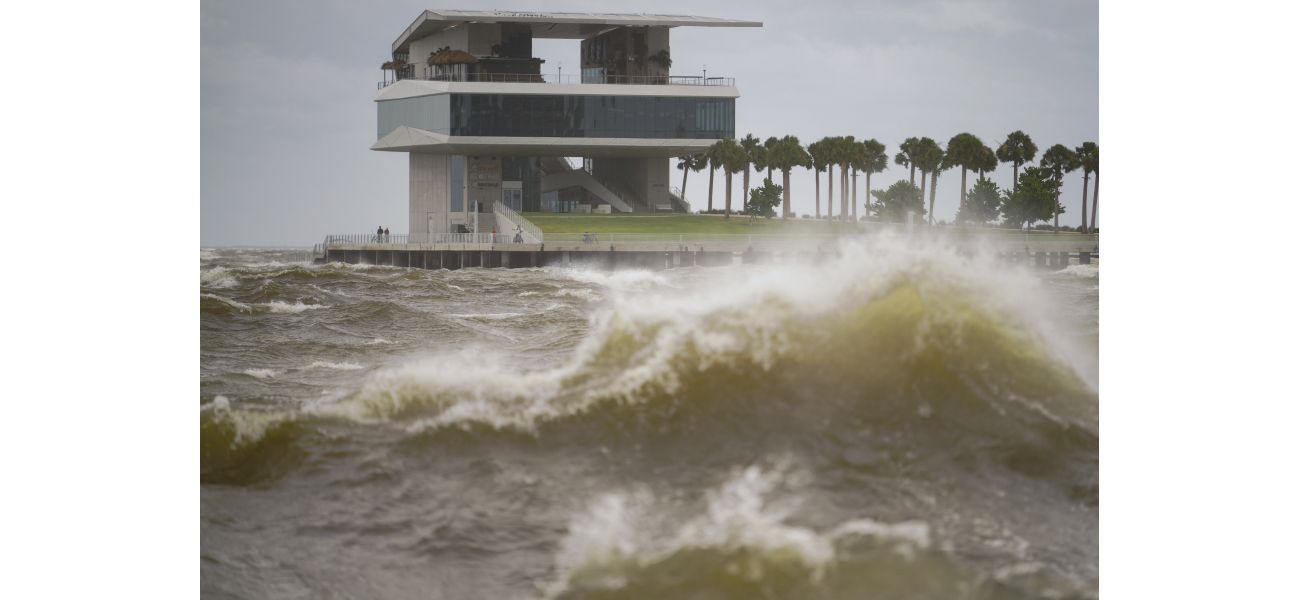Hurricane Helene hits northwestern Florida as a Category 4 storm.
Many states are experiencing emergencies due to powerful winds causing power outages for over 250,000 properties.
September 27th 2024.

Hurricane Helene, a fast-moving and powerful storm, has just made landfall in Florida's Big Bend area. Forecasters are warning of potential catastrophic flooding and strong winds that could cause extensive damage across the southeastern United States. Along with this, the storm has brought heavy rains and flash floods, which have already caused loss of life and property.
As Hurricane Helene approached, authorities in Georgia reported two fatalities, possibly caused by a tornado, and Florida Governor Ron DeSantis confirmed one death on Interstate 4 when a falling sign struck a passing car. The storm has also caused widespread power outages, affecting over 1 million homes and businesses in Florida and over 50,000 in Georgia.
The severity of the situation has prompted states of emergency to be declared in Florida, Georgia, the Carolinas, Virginia, and Alabama. Meanwhile, in the Pacific, former Hurricane John has strengthened back into a hurricane and is threatening Mexico's western coast with flash flooding and mudslides. In the Atlantic, Tropical Storm Isaac has formed and is expected to become a hurricane as it moves away from the US.
Governor DeSantis has urged caution and asked people to stay indoors, as the dangerous conditions continue. He has also confirmed that more fatalities are possible and has called for the support of 3,500 National Guardsmen to aid in response efforts. He also asked for prayers for those affected by the storm, as it is expected to cause significant damage and loss of life.
Hurricane Helene made landfall near the city of Perry in northwestern Florida as a Category 4 storm, with maximum sustained winds of 140 mph. The National Hurricane Center has warned of potential storm surges up to 20 feet, which could be catastrophic and unsurvivable in some areas. Hurricane warnings and flash flood warnings have been extended beyond the coast, reaching into northern Georgia and western North Carolina.
The impact of the storm can already be seen with over 885,000 customers in Florida without power. The majority of these outages are in the Big Bend area where Helene made landfall. And while the storm is no longer a hurricane, it continues to bring heavy rains and flash flooding as it moves slowly along the coast of Mexico's Michoacan state.
John, the former hurricane that hit Mexico earlier in the week, has also reformed into a hurricane after weakening inland. It is expected to weaken again as it moves along the coast, but still poses a threat with strong winds and potential flash flooding. The storm has already caused significant damage and loss of life in Mexico, and the hurricane center is closely monitoring its movements.
On Thursday evening, Hurricane Helene, a fast-moving Category 4 storm, slammed into the Big Bend area of Florida's northwestern coast. The storm brought with it the potential for catastrophic storm surges, damaging winds, heavy rains, and flash floods that could affect hundreds of miles inland in the southeastern US, according to forecasters.
As Helene approached, reports came in of two fatalities in south Georgia, possibly due to a tornado, and one death in Florida where a driver was hit by a falling sign while traveling on Interstate 4. The storm also knocked out power to over 1 million homes and businesses in Florida and over 50,000 in Georgia.
States of emergency were declared in Florida, Georgia, the Carolinas, Virginia, and Alabama, as officials prepared for the worst. In the Pacific, former Hurricane John regained strength and was downgraded to a tropical storm as it moved along the western coast of Mexico, bringing the threat of flash flooding and mudslides.
Meanwhile, Tropical Storm Isaac formed in the Atlantic Ocean and was expected to intensify and possibly become a hurricane by the end of the week, according to forecasters.
Governor Ron DeSantis of Florida urged residents to stay safe and take precautions as the storm continued to wreak havoc. He reported that more fatalities were likely as the storm progressed and that 3,500 National Guardsmen were ready to assist in the aftermath.
As Helene made landfall in northwestern Florida, with maximum sustained winds of 140 mph, officials warned of catastrophic flooding along the Gulf Coast. The National Hurricane Centre in Miami reported that the storm hit near Perry, Florida, in the Big Bend area, around 11:10 p.m. EDT.
Warnings extended beyond the coast, up into northern Georgia and western North Carolina, as the storm brought heavy rains and strong winds. The threat of power outages also continued to rise, with over 885,000 customers in Florida without power as of 11 p.m. EDT, according to poweroutage.us.
Meanwhile, former Hurricane John, which initially hit Mexico on Monday as a Category 3 hurricane, was downgraded to a tropical storm as it moved slowly along the coast of Michoacan. The storm, which brought destruction and chaos to the southern Pacific coast, regained strength and was once again downgraded to a hurricane before weakening again.
The US National Hurricane Centre warned of severe flash flooding in coastal areas, as the storm continued to move slowly along the coast. Residents were urged to take precautions and stay safe as the storm was expected to weaken further on Thursday night and into Friday.
As Hurricane Helene approached, authorities in Georgia reported two fatalities, possibly caused by a tornado, and Florida Governor Ron DeSantis confirmed one death on Interstate 4 when a falling sign struck a passing car. The storm has also caused widespread power outages, affecting over 1 million homes and businesses in Florida and over 50,000 in Georgia.
The severity of the situation has prompted states of emergency to be declared in Florida, Georgia, the Carolinas, Virginia, and Alabama. Meanwhile, in the Pacific, former Hurricane John has strengthened back into a hurricane and is threatening Mexico's western coast with flash flooding and mudslides. In the Atlantic, Tropical Storm Isaac has formed and is expected to become a hurricane as it moves away from the US.
Governor DeSantis has urged caution and asked people to stay indoors, as the dangerous conditions continue. He has also confirmed that more fatalities are possible and has called for the support of 3,500 National Guardsmen to aid in response efforts. He also asked for prayers for those affected by the storm, as it is expected to cause significant damage and loss of life.
Hurricane Helene made landfall near the city of Perry in northwestern Florida as a Category 4 storm, with maximum sustained winds of 140 mph. The National Hurricane Center has warned of potential storm surges up to 20 feet, which could be catastrophic and unsurvivable in some areas. Hurricane warnings and flash flood warnings have been extended beyond the coast, reaching into northern Georgia and western North Carolina.
The impact of the storm can already be seen with over 885,000 customers in Florida without power. The majority of these outages are in the Big Bend area where Helene made landfall. And while the storm is no longer a hurricane, it continues to bring heavy rains and flash flooding as it moves slowly along the coast of Mexico's Michoacan state.
John, the former hurricane that hit Mexico earlier in the week, has also reformed into a hurricane after weakening inland. It is expected to weaken again as it moves along the coast, but still poses a threat with strong winds and potential flash flooding. The storm has already caused significant damage and loss of life in Mexico, and the hurricane center is closely monitoring its movements.
On Thursday evening, Hurricane Helene, a fast-moving Category 4 storm, slammed into the Big Bend area of Florida's northwestern coast. The storm brought with it the potential for catastrophic storm surges, damaging winds, heavy rains, and flash floods that could affect hundreds of miles inland in the southeastern US, according to forecasters.
As Helene approached, reports came in of two fatalities in south Georgia, possibly due to a tornado, and one death in Florida where a driver was hit by a falling sign while traveling on Interstate 4. The storm also knocked out power to over 1 million homes and businesses in Florida and over 50,000 in Georgia.
States of emergency were declared in Florida, Georgia, the Carolinas, Virginia, and Alabama, as officials prepared for the worst. In the Pacific, former Hurricane John regained strength and was downgraded to a tropical storm as it moved along the western coast of Mexico, bringing the threat of flash flooding and mudslides.
Meanwhile, Tropical Storm Isaac formed in the Atlantic Ocean and was expected to intensify and possibly become a hurricane by the end of the week, according to forecasters.
Governor Ron DeSantis of Florida urged residents to stay safe and take precautions as the storm continued to wreak havoc. He reported that more fatalities were likely as the storm progressed and that 3,500 National Guardsmen were ready to assist in the aftermath.
As Helene made landfall in northwestern Florida, with maximum sustained winds of 140 mph, officials warned of catastrophic flooding along the Gulf Coast. The National Hurricane Centre in Miami reported that the storm hit near Perry, Florida, in the Big Bend area, around 11:10 p.m. EDT.
Warnings extended beyond the coast, up into northern Georgia and western North Carolina, as the storm brought heavy rains and strong winds. The threat of power outages also continued to rise, with over 885,000 customers in Florida without power as of 11 p.m. EDT, according to poweroutage.us.
Meanwhile, former Hurricane John, which initially hit Mexico on Monday as a Category 3 hurricane, was downgraded to a tropical storm as it moved slowly along the coast of Michoacan. The storm, which brought destruction and chaos to the southern Pacific coast, regained strength and was once again downgraded to a hurricane before weakening again.
The US National Hurricane Centre warned of severe flash flooding in coastal areas, as the storm continued to move slowly along the coast. Residents were urged to take precautions and stay safe as the storm was expected to weaken further on Thursday night and into Friday.
[This article has been trending online recently and has been generated with AI. Your feed is customized.]
[Generative AI is experimental.]
0
0
Submit Comment





